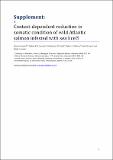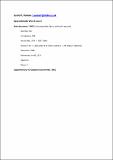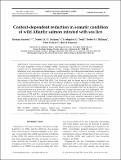Files in this item
Context-dependent reduction in somatic condition of wild Atlantic salmon infested with sea lice
Item metadata
| dc.contributor.author | Susdorf, Roman | |
| dc.contributor.author | Salama, Nabeil | |
| dc.contributor.author | Todd, Christopher David | |
| dc.contributor.author | Hillman, Robert | |
| dc.contributor.author | Elsmere, Paul | |
| dc.contributor.author | Lusseau, David | |
| dc.date.accessioned | 2019-11-15T00:36:43Z | |
| dc.date.available | 2019-11-15T00:36:43Z | |
| dc.date.issued | 2018-11-15 | |
| dc.identifier | 256866540 | |
| dc.identifier | ba657ca3-4698-4c13-b53f-040d83f1bb22 | |
| dc.identifier | 85056836860 | |
| dc.identifier | 000450352900008 | |
| dc.identifier.citation | Susdorf , R , Salama , N , Todd , C D , Hillman , R , Elsmere , P & Lusseau , D 2018 , ' Context-dependent reduction in somatic condition of wild Atlantic salmon infested with sea lice ' , Marine Ecology Progress Series , vol. 606 , pp. 91-104 . https://doi.org/10.3354/meps12746 | en |
| dc.identifier.issn | 0171-8630 | |
| dc.identifier.other | ORCID: /0000-0002-9690-2839/work/60427272 | |
| dc.identifier.uri | https://hdl.handle.net/10023/18929 | |
| dc.description | Funding: Marine Scotland Science (MSS). | en |
| dc.description.abstract | Wild Atlantic salmon Salmo salar stocks have globally declined over recent decades. On their migratory return to coastal waters, individuals typically are infested by ectoparasitic caligid sea lice (Lepeophtheirus salmonis Krøyer, Caligus elongatus Nordmann). Infestation in laboratory trials can exert non-lethal impacts on the host fish, including increased stress levels and reduced growth, physical condition and swimming performance. However, to date no evidence exists for non-lethal effects of sea lice on wild adult Atlantic salmon. Using observations for > 6000 return-migrant adult salmon captured from the coastline at Strathy Point (SP), North Scotland, in the estuary of the River North Esk (NE), East Scotland, and the lower reach of the River Tamar (TA), Southwest England, we show that the somatic condition (weight at length) of wild salmon is associated with mobile sea lice density. This putative sea lice-mediated reduction of condition varied with year and seasonal date of freshwater return, and increased with the proportion of adult female parasites on a given fish. Influence of host sex, sea-age and smolt age was negligible. The estimated impact differed between the 3 sampling sites likely due to underestimation of infestation levels at NE and TA — largely attributable to negative influences of reduced salinity on parasite retention prior to sampling. Caligid infestation in the present samples explained a small, but discernible, proportion of the variation in host condition. Reductions in somatic condition of Atlantic salmon are associated with disproportionate declines in accreted lipid reserves, which are critical to up-river migration and ultimately the provisioning of eggs. | |
| dc.format.extent | 1650349 | |
| dc.format.extent | 3241375 | |
| dc.format.extent | 1043364 | |
| dc.language.iso | eng | |
| dc.relation.ispartof | Marine Ecology Progress Series | en |
| dc.subject | Atlantic salmon | en |
| dc.subject | Salmo salar | en |
| dc.subject | Condition effect | en |
| dc.subject | Parasite-host interaction | en |
| dc.subject | Sea lice | en |
| dc.subject | Lepeophtheirus salmonis | en |
| dc.subject | Caligus elongatus | en |
| dc.subject | QH301 Biology | en |
| dc.subject | SH Aquaculture. Fisheries. Angling | en |
| dc.subject | NDAS | en |
| dc.subject | SDG 14 - Life Below Water | en |
| dc.subject.lcc | QH301 | en |
| dc.subject.lcc | SH | en |
| dc.title | Context-dependent reduction in somatic condition of wild Atlantic salmon infested with sea lice | en |
| dc.type | Journal article | en |
| dc.contributor.institution | University of St Andrews. School of Biology | en |
| dc.contributor.institution | University of St Andrews. Marine Alliance for Science & Technology Scotland | en |
| dc.contributor.institution | University of St Andrews. Scottish Oceans Institute | en |
| dc.identifier.doi | 10.3354/meps12746 | |
| dc.description.status | Peer reviewed | en |
| dc.date.embargoedUntil | 2023-11-15 |
This item appears in the following Collection(s)
Items in the St Andrews Research Repository are protected by copyright, with all rights reserved, unless otherwise indicated.



